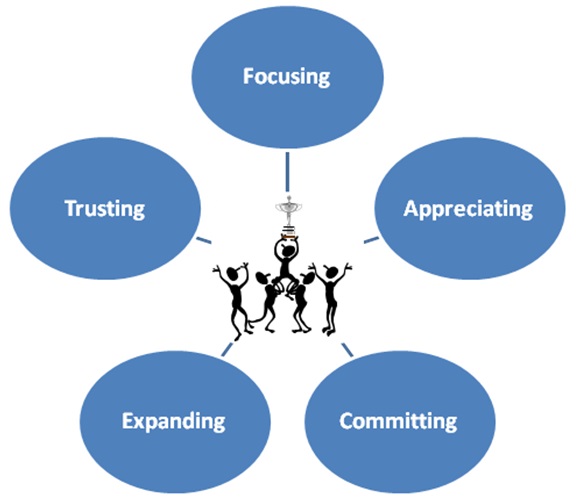Taking this social context one step further, my model also acknowledges the social context of the athlete as part of a “team.” We all have people who support us in our lives and growth: family, friends, teachers, colleagues, health care professionals, etc.
 My model includes the client’s “team” standing behind, ready to help out, ready to practice and play. This team evolves during the client’s life, but will be in place before this coaching relationship starts.
My model includes the client’s “team” standing behind, ready to help out, ready to practice and play. This team evolves during the client’s life, but will be in place before this coaching relationship starts.
So what could make the partnership unequal? Even though the coaching community teaches that the coach doesn’t need to know the content, I believe that a coach brings greater value to the client if the coach can really be an equal participant. If my client wants to be coached in an issue with marketing their business, for example, my knowledge is limited and theirs might be too. I can coach this client, up to a point, and I need to be able to identify what that point is. One of my strategies is to seek and develop partnerships with other coaches, consultants, and trainers in areas beyond my expertise, so that I can help link my clients to the right people when I reach that point.
The Coaching Conversation
I started my coaching practice using Tim Gallwey’s Inner Game model. My model adopts some approaches from Gallwey. First, my model is not a step by step process. My experience is that life isn’t that clean; we tend to work more “organically,” working on our goals incrementally. I also like that Gallwey calls the elements of his model “conversations.” In my model, I can use the sequence shown below, but I’m more likely to bounce around them organically based on what the client brings up.
My model includes 5 key conversations that focus on success factors for athletes: Focusing, Appreciating, Committing, Expanding, and Trusting. These FACETs of the athlete are, intentionally, verbs instead of nouns to acknowledge the athlete being in motion.
 What do the FACETs mean?
What do the FACETs mean?
How do I use the FACETs in a coaching conversation?
By using my model’s view of the multi-faceted athlete, I can approach each conversation from these perspectives:
[1] Quoted from Sport and business coaching: Perspective of a sport psychologist, by Sandy Gordon, Australian Psychologist, December 2007. Original reference: Robertson, A., & Abbey, G. (2003). Managing talented people.
Harlow, UK: Pearson Education.
[2] Quoted from Structure and characteristics of effective coaching practice, by Qing Wang, The Coaching Psychologist, June 2013. Original reference: O’Broin, A. & Palmer, S. (2009). Co-creating an
optimal coaching alliance: A cognitive behavioural coaching perspective. International Coaching Psychology Review, 4(2), 184–194.